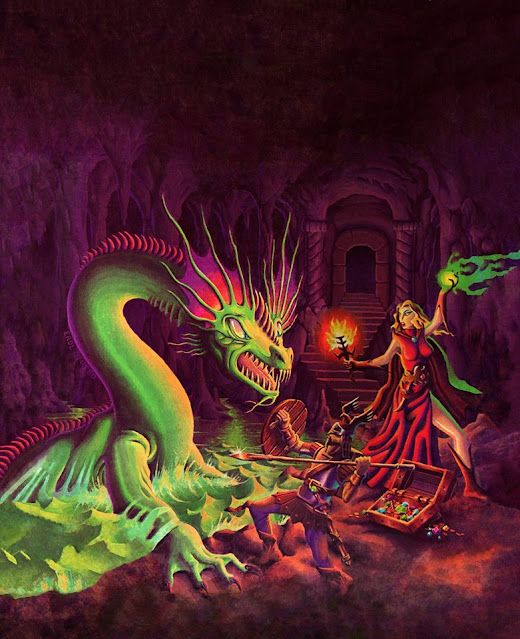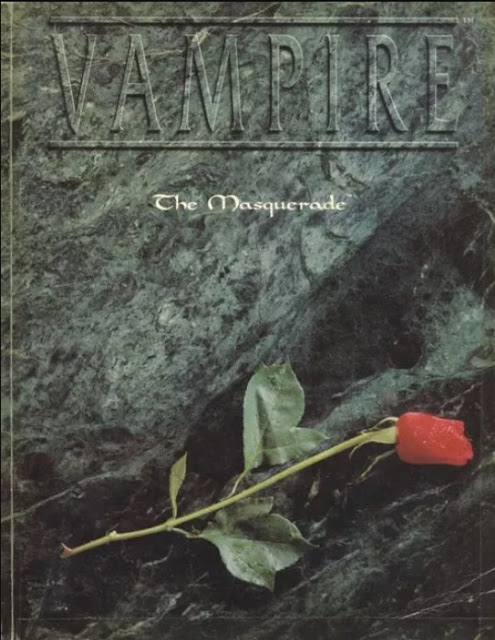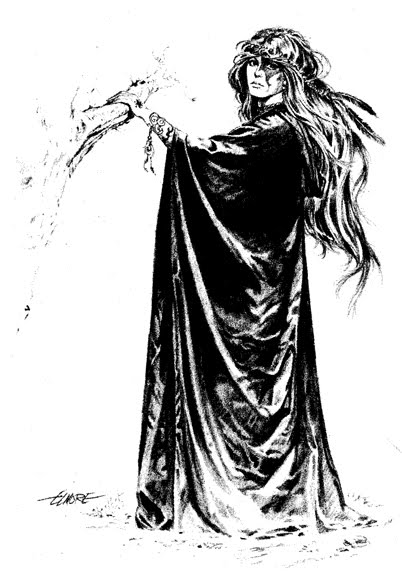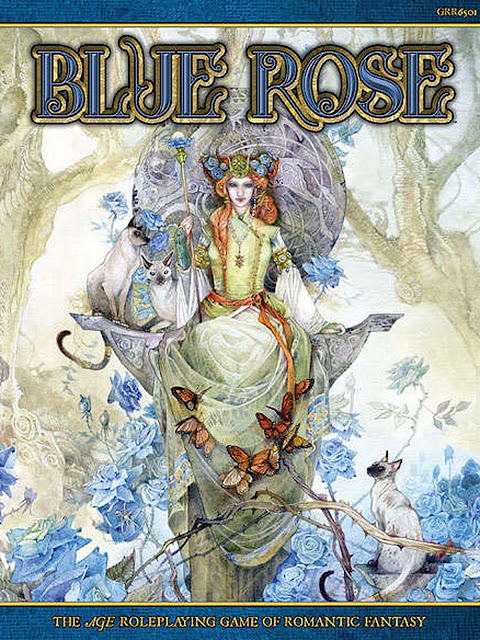
On the tail of the Old School Renaissance has come another movement—the rise of the fanzine. Although the fanzine—a nonprofessional and nonofficial publication produced by fans of a particular cultural phenomenon, got its start in Science Fiction fandom, in the gaming hobby it first started with
Chess and
Diplomacy fanzines before finding fertile ground in the roleplaying hobby in the 1970s. Here these amateurish publications allowed the hobby a public space for two things. First, they were somewhere that the hobby could voice opinions and ideas that lay outside those of a game’s publisher. Second, in the Golden Age of roleplaying when the Dungeon Masters were expected to create their own settings and adventures, they also provided a rough and ready source of support for the game of your choice. Many also served as vehicles for the fanzine editor’s house campaign and thus they showed another DM and group played said game. This would often change over time if a fanzine accepted submissions. Initially, fanzines were primarily dedicated to the big three RPGs of the 1970s—
Dungeons & Dragons,
RuneQuest, and
Traveller—but fanzines have appeared dedicated to other RPGs since, some of which helped keep a game popular in the face of no official support.
Since 2008 with the publication of
Fight On #1, the Old School Renaissance has had its own fanzines. The advantage of the Old School Renaissance is that the various Retroclones draw from the same source and thus one Dungeons & Dragons-style RPG is compatible with another. This means that the contents of one fanzine will compatible with the Retroclone that you already run and play even if not specifically written for it.
Labyrinth Lord and
Lamentations of the Flame Princess Weird Fantasy Roleplay have proved to be popular choices to base fanzines around, as has
Swords & Wizardry. Another choice is the
Dungeon Crawl Classics Role Playing Game.
Night Soil #Zero takes the
Dungeon Crawl Classics Role Playing Game as its direct inspiration. Specifically, it draws from the artwork of the fourth printing of the core rules to provide images that have in turn inspired the creation of monsters, magical items, spells, tables, and more that the Judge can bring to her game or campaign. It is a lovely idea, but the result is a bit of a mess, a hodgepodge of miscellaneous things and entries that unless you somehow know the artwork and its order in the fourth printing of the
Dungeon Crawl Classics Role Playing Game, may have you leafing through the pages of the admittedly short
Night Soil #Zero in order to find something. Even at twenty-four pages, an index or list of contents and page numbers would not have gone amiss here.
Published by
Inner Ham—previously known for
Fantastic Exciting Imaginative: The Holmes Art ’Zine—
Night Soil #Zero, opens with its first monster, the Terrordactyl, a giant reptile bird with retchingly awful bad breath and capable of snapping a target’s neck on a roll of a natural twenty, so a nasty thing to confront the Player Characters with. Not that interesting though. Weirder though, and definitely more modern, are the Horned Lobsterclops, which fight luchadors and underprepared explorers and scientists. Beating one in initiative trades accuracy for speed—the attacker’s die decreases by one step, and if a Horned Lobsterclop licks an opponent, on a failed Will save, it can cause them to scream and writhe, attempt to persuade the nearest ally to run (causing both to lose their actions in the next round), pass out temporarily, or simply flay uselessly at the creature’s sturdy carapace. This has a much pulpier feel then the other monsters and though fun, does need a suitably pulpy style of game to use it. An easier to use creature is the Phlogiston Elemental, which can appear whenever magic goes awry and takes more damage from wooden weapons than metal ones, making it a more difficult thing to defeat.
Perhaps the most flexible monster in the inaugural issue of the fanzine, is the Dogmen. Their love of bones means they often serve necromancer, and they often make good Warriors and Clerics. They can use all four Human Classes, but only up to Third Level. Although small, they have a strong bite, possess a keen sense of smell, and even their very presence enhances the effects of bone magic! On the downside, they are easily distracted, having to make Personality checks to avoid an Action Die and being bumped down a die for Saving Throws. Amusingly, this is called ‘Squirrel!’ and is a suitably silly feature for the henchmen role they are designed to fulfil. The other henchmen-type monsters are Death Guards, who have been hired and erroneously led to believe that they have been imbued with magical ability and otherworldly prowess. As terrible as they are, what they actually have is incredible self-belief and working together can inspire themselves to improve their Armour Class, Hit Points, speed, and so on, though only once per combat for each of the four such tricks they know. This is a concept worth exploring, as it could also be applied to cultists or other devotees, and more, but here it is rough and undeveloped.
The magical items begin with
Horseshoes of Returning, innocuous, but favourite weapons for Halflings as they return to the hand once thrown. The other Halfling item of magic is the
Pipe of Contentment, which can be smoked to regain points of Luck and even restore damage done to Intelligence or Personality. These are nicely done, flavoursome items that will please any halfling Player Character. From small to large as ‘Dead Giant, Uses of a’ suggests exactly that, whether keeping Chaos magic at bay if properly preserved, allowing its blood to spill and render the land infertile, feasted upon to increase Personality, the skull stolen to use as a cauldron by witches, and so on. For the Wizard, there is the
Horned Cap, which makes him look like a badass and so might get him a free drink or a warmer bed, just to ensure that he is happy, or even potentially gain bonuses if Luck is burned, when casting spells related to bones, animals, or fear, and the
Dragon Staff, which grants the user proficiency in, but not the capability of flight and a unique, randomly determined dragon power. There is even an
Enchanted Skull Bookrest against which wizards and other magic-users rest their tomes and digests of knowledge where they can easily be read and understood, only for their content to shift into gibberish the moment they are taken away from the skull. It might protect a spell or other work of magic from prying eyes, but what if an
Enchanted Skull Bookrest was stolen and one of the books which rested upon it, contained something of vital importance? Who would pay to get back and why?
The Cauldron of Contact aids in the fashioning of alchemical substances from other realms when burned over wood from Elfland, Faerie Forests, or Dryad Groves, or even contacting beings from those realms if wood cauldron from Elfland, Faerie Forests, or Dryad Groves is heated in the cauldron. There are potential side effects, such as the King of Elfland finding a future opportunity to strike the user or rolling corruption or all footwear being wet inside, causing the user’s feet to rot. This could be an interesting item, but is rather undeveloped as there are no mechanics as to when the side effects occur.
The three spells in the issue are
The Eye of Chaos,
Shadowblend, and
Seeking Shrieking Shrike. The first is a Second Level spell for Clerics which creates a glowing eye-like symbol that grants a bonus to Chaos-aligned creatures or zaps Law-aligned creatures; the second a First Level Wizard spell that enables him and his companions to blend into the shadows to increase their Armour Class; and the third a Second Level Cleric spell that creates an animal-shaped bolt which seeks out its target and hits on the next round after being cast. Seeking Shrieking Shrike is a fun spell, the others less so, but interesting additions to find in spell books or being cast by NPCs.
Other items are found in certain locations, such as the
Speaking Headstone, which might not know much about the person whose grave it marks, but has seen a lot of vistors to the cemetery over the years, so may have the answers that the Player Characters are looking for. Unfortunately, it has a tendency to complain about the lack of crematorial etiquette and actually, would like a change of scenery, or even a holiday… The
Speaking Headstone is just such a ridiculous idea, but it sounds a lot of fun for the Judge to roleplay, and her players and their characters are sure to loath it. Other locations include the partially submerged skull of a titan, which can be entered and then the length of its bones explored, the deeper the Player Characters penetrate, the better their magic, and a Hanging Tree whose potential effects include wiping from existence anyone who is hung from its branches or transforming them into some form of restitution for their crimes, or even causing another corpse to animate as one of the various undead. The Judge is free to choose, two of the options suggesting story possibilities, which the last feels almost traditional.
Physically,
Night Soil #Zero is scrappy—intentionally scrappy. The artwork is likewise intentionally rough. Together with the use of the typewriter style font, the look of the fanzine is designed to match that of the fanzines and books of the seventies and even then their lack of professionalism. It may or may not trigger your sense of nostalgia, but that does not necessarily detract from the readability of the contents of the fanzine.
Night Soil #Zero is a mostly entertaining medley of the miscellaneous and the muddled, organised only by reference to another book. (Which is its major problem.) The inspired sits alongside the indifferent and reading the slim volume is very much a matter of whether you are going to get the former or latter, from one page to the next—or even on the same page!
Night Soil #Zero is the equivalent of the blind box purchase for the
Dungeon Crawl Classics Role Playing Game—there are definitely things in here that will inspire the Judge and there are definitely things which will leave him uninspired.















